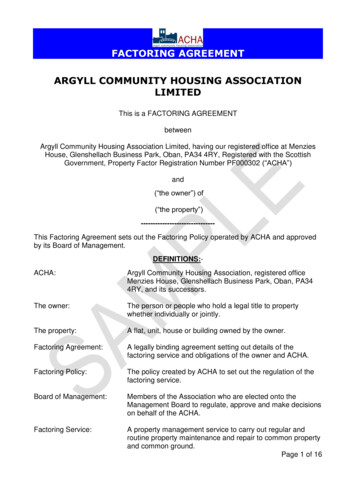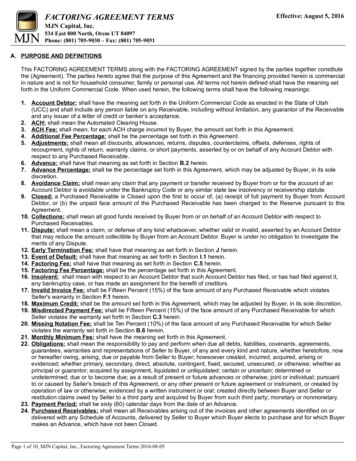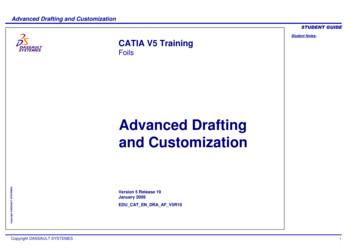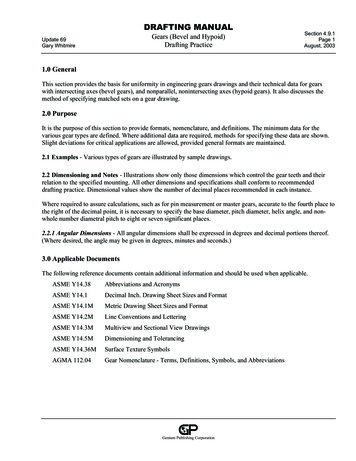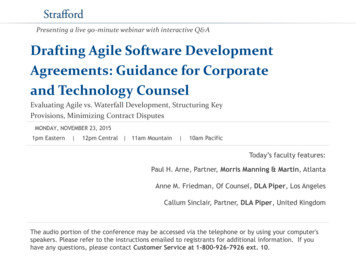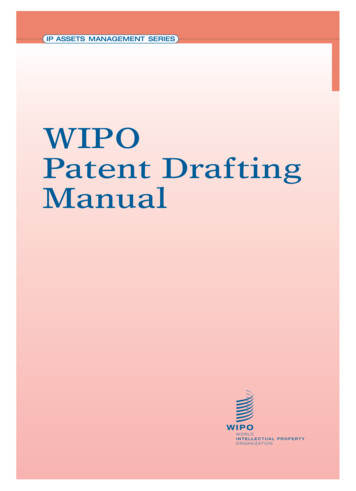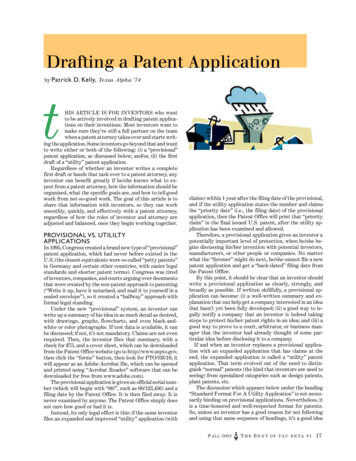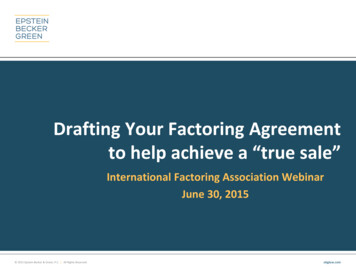
Transcription
Drafting Your Factoring Agreementto help achieve a “true sale”International Factoring Association WebinarJune 30, 2015 2015 Epstein Becker & Green, P.C. All Rights Reserved.ebglaw.com
Presented byDavid B. TatgeEpstein Becker & Green, P.C.dtatge@ebglaw.com202-861-1875 2015 Epstein Becker & Green, P.C. All Rights Reserved. ebglaw.com2
AGENDA 2015 Epstein Becker & Green, P.C. All Rights Reserved.ebglaw.com
TOPICS WE WILL DISCUSS TODAY INCLUDE: How “modern” factoring developed Risks that a commercial factor does and does not accept from its client Factoring accounts on a non-recourse, partial non-recourse, partial recourseand a full recourse basis Contractual language by which factors assume credit risk Contractual language by which factors shift risk to their clients “Old-line factoring" – how the term developed and what it means What courts look for in determining if there was a "true sale“ of accounts Terms which might bolster "true sale" treatment; Terms which could damage "true sale" treatment; Terms which courts may (or may not) view as inconsistent with a "true sale"of accounts; Importance of the contractual “choice of law” in full recourse factoring 2015 Epstein Becker & Green, P.C. All Rights Reserved. ebglaw.com4
DRAFTING TO HELP ACHIEVE A TRUE SALERequires knowledge of, among other things: Risks which commercial factors in America have “traditionally” assumed;Contract language which evidences the factor’s assumption of these risks;Whether, how and why these “traditional” assumed risks help create a “true sale”of accounts under American law;The ways modern American factors have reduced and varied the levels of risk“traditionally” assumed and the impact thereof on the “true sale” analysis;Risks that commercial factors in America do not assume and how this impacts the“true sale” analysis;How full recourse factoring developed, historically, and the extent to which itresembles both: (1) “traditional” factoring and (2) commercial loan transactions;How “factoring” has been defined by American courts; andThe various facts and circumstances which American courts weigh in their “truesale” legal analysis. 5 2015 Epstein Becker & Green, P.C. All Rights Reserved. ebglaw.com5
FACTORING SERVICES(Historic and Modern) 2015 Epstein Becker & Green, P.C. All Rights Reserved.ebglaw.com
Factoring servicesAt common law, factors were commissioned sales agents and took credit riskUnder English common law, from 1300 or so to the late 1800s ,commercial factors were sales agents for their principals, oftensellers of raw materials, agricultural products, or manufactured goods. In consideration of a sales commission the factor: Stored consigned client inventory, often on-site; Provided sales, styling and marketing advice to the client; Provided financing to the client, by discounting accounts receivable and making post-sale advances to the client thereon, say,at 50-80% of the sale price, prior to actual collection; and Performed bookkeeping and collection functions associated with these services.Moreover, in consideration of a supplemental del credere commission, often 2.5-5% of the market price, common law factors: On shipped goods, accepted full “credit risk” that the account would not collect at maturity due solely to the account debtor’sfinancial inability to pay. The factor’s principal, the seller, still keeping risk of non-payment due to “quality” issues.(1) Foreign sellers demanded their local factors take a del credere commission to avoid credit losses from selling into foreignmarkets. Factors, being local, could gauge the customer’s ability to pay and were better positioned to take the credit risk.(2) If a factored account did not collect at maturity, due solely to the customer’s inability to pay, the factor paid its client theinvoice price and took the full credit loss (net of the del credere commission received). Upon this payment, the factor’sposition ripened from being surety for the legal owner of the account (the factor’s principal) to full owner of theaccount (via subrogation).Factoring came to America with the Pilgrims (see AFL Ch. 1) and has been a form of commercial finance here since that timeFactoring died out in England in the late 1800s, only to be re-introduced to England by CIT in 1960. See AFL 2013 Cumul. Supp. Ch. 17 2015 Epstein Becker & Green, P.C. All Rights Reserved. ebglaw.com7
Factoring servicesProvided by “modern” factors, depending on the particular agreement“Modern” factoring arose in America between 1889 and 1905 Marketing and sales advice were dropped from the factor’s servicesMoreover, over time, American factors no longer stored inventory on-site for their clientsModern American factors still provide several client services, including: Credit protection (and credit analysis) in “traditional” nonrecourse factoring facilities, in consideration of theclient’s payment of factoring commissions (aka discount fees).Credit protection is also provided, in lesser degrees, via other modern factoring products as well. See below. Financing for the client in certain forms of factoring (i.e., advance factoring), by a cash “advance” to theclient when the subject accounts are purchased, often at 70-95% of the purchase price;NOTE 1: In “advance factoring” some factors expressly treat their advances as interest-bearing loans, repaid via set-off against the factor’s obligation todisburse the full purchase price when due. Others treat their advances as non-interest bearing partial prepayments of the purchase price.NOTE 2: In “maturity factoring” no client financing is provided; rather, the factor pays the full purchase price to the client on [the average] maturity ofthe subject accounts purchased that month (or for those accounts purchased on the particular schedule/batch);NOTE 3: In “collection factoring” no client financing is provided; rather, the factor pays the full price to the client at collection of the subject accounts. Billing services (in certain factoring contracts);Collection services (in notification factoring and, after default, in non-notification factoring also); andSales administration (ledgering purchased accounts and collections thereon)NOTE: Some modern factors also provide non-factoring services, such as asset-based loans, letters of credit, purchase order and supply chain finance, etc.8 2015 Epstein Becker & Green, P.C. All Rights Reserved. ebglaw.com8
RISKS TRADITIONALLYASSUMED BYCOMMERCIAL FACTORS 2015 Epstein Becker & Green, P.C. All Rights Reserved.ebglaw.com
Factors traditionally assume ONLY full “credit risk”Defined, traditionally, as the account debtor’s “financial inability to pay” At common-law, del credere factors accepted just ONE risk – full credit risk that a factored account would not timely collectwhen due. In consideration of the client paying a supplemental del credere commission, 2.5 - 5% or so of the purchase price.Del credere commissions came to New York City from the Continent around 1800, imposed by European textile makers.“Modern” factoring arose from 1895-1905. Modern factors bought accounts “without recourse” and, as before, assumed fullcredit risk. If a factored account was not collected at maturity due solely to the “financial inability to pay” of the accountdebtor (client customer) obligated thereon the factor thereupon paid its client the invoice amount and suffered an associatedcredit loss (net of the discount fee received, and whatever the factor could later collect from the account debtor). Traditionalnonrecourse factors still take this same full credit risk today, under maturity, collection and advance factoring facilities.“Financial inability to pay” – is not defined in the case law. But, generally, it looks to the legal or practical inability of theaccount debtor to pay on a purchased account. “Financial inability” includes an account debtor’s failure to pay due to its:(1)bankruptcy (voluntary or involuntary);(2)making an assignment for the benefit of creditors;(3)being placed in receivership;(4)foreclosure/seizure of its assets by a secured lender, landlord, tax authority, or other creditor under: (i) a writ ofexecution; (ii) a writ of attachment; (iii) a levy, or some similar remedy;(5)being equitable insolvent (in the sense of not being generally able to pay on its accounts when due);(6)acceptance of a compromise among its creditors;(7)voluntary liquidation or dissolution;(8)for governmental account debtors – appointment of a government control board or similar body which freezespayments on accounts, or an inability to pay rooted in a government shutdown or budget freeze, or rooted in afailure to appropriate the necessary funds,(9)etc.Note: Balance sheet insolvency is not stated to be “financial inability” as companies whose liabilities exceed their assets, as fair valued, can often keep paying on their debts for quite some time.10 2015 Epstein Becker & Green, P.C. All Rights Reserved. ebglaw.com10
Factors “traditionally” assume ONLY full “credit risk”The effect of accepting full credit risk1. The principal effect of a nonrecourse factor assuming full credit risk as to purchased accountsis that if a purchased account does not timely collect due solely to assumed credit risk, theaccount is nonetheless “deemed” to be collected by the nonrecourse factor.2. Upon “deemed” collection the factor has to make a “balance payment” to its client, “as if” thepurchased account(s) had actually collected.3. For this purpose, the factor’s “balance payment” equals the difference between the purchaseprice of the subject account(s), less any initial advance(s) thereon, less factoring fees andcommissions due.4. When this “deemed collection” occurs is a matter of contract: Most factoring agreements of the very large old-line factors (Wells Fargo, CIT, Rosenthal & Rosenthal, Capital Business Credit, BB&T, Sterling Factors) state that if a purchased account doesnot collect within an agreed time, say, 120 days from invoice, the lag is deemed to arise from the financial inability of the account debtor to pay (so is within an assumed risk of “financialinability to pay”). Whereupon the account is deemed collected and the factor makes its balance payment to the client at that time, subject to the factor’s later right to recover the payment if it issubsequently shown that the delay in collection occurred for some reason other than assumed credit risk, such as due to the account debtor disputing the quality or quantity of goods and servicesdelivered to it by the factor’s client. Some smaller nonrecourse factors factor in just this manner also. [Note that four of the “big six” nonrecourse factors today are bank owned, with onlyRosenthal & Rosenthal and Capital Business Credit still being privately held.] Other smaller nonrecourse factors and their clients contractually reverse the presumption. They agree that if a purchased account does not collect within the agreed period, say, 120 days frominvoice, the delay in collection is “deemed” to arise because the account debtor disputes its obligation to pay on the account, whereupon it is charged-back absent reasonable proof sent by theclient to the factor at this time, or within ten days or so thereafter, establishing that either: (1) the account is not disputed and will soon pay (perhaps evidenced by a reaffirmation letter from theaccount debtor so stating and promising to pay quickly) [in which case the account is not charged-back and the factor’s ownership and full credit risk both continue] or (2) the account did notyet collect due solely to credit risk assumed by the factor [in which case the factor treats the account as “deemed” collected and thereupon makes its balance payment to the client]. 2015 Epstein Becker & Green, P.C. All Rights Reserved. ebglaw.com11
Factors traditionally assume ONLY full “credit risk”Purchasing Accounts with full credit risk creates a “true sale” Factors who purchase accounts and accept full credit risk thereon, unlimitedby time, assuming their agreement is otherwise consistent with therequirement to find a “true sale” (such as, for example, a stated intent tocreate a true sale, control over the collected proceeds of the purchasedaccounts, right to re-sell or pledge the purchased accounts, etc.), can expectthe court to recognize the transaction as a “true-sale.” See e.g. American Factoring Law Ch. 1.IV.B, Ch. 4.II.E. A representative case is Matrix International Textiles, Inc. v. Jolie Intimates,Inc., 801 N.Y.S. 2d 236, 2005 N.Y. Misc. LEXIS 888 at **6,7 (N.Y. Civ. Ct.2005), cited on page 288 of the main volume of American Factoring Law:“The core of the Factoring Agreement, however, is SunTrust’s purchase from Matrix of ‘certain accounts receivable created by [Matrix’s] saleof goods to .customers approved by’ SunTrust, clearly including Jolie. (See P1.) The purchase and sale of accounts is ‘withoutrecourse to [Matrix] for insolvency or nonpayment, after the goods have been actually delivered to and finally accepted without claim or dispute by[Matrix’s] customer.’All of the evidence points to a sale of the accounts without recourse and SunTrust’s ownership and control of the account.”The decision also states: “A review of the Factoring Agreement between Matrix and SunTrust Bank reveals a traditional factoringagreement in which ‘the factor acts as the insurer only of its client’s customers’ insolvency not the quality of its client’s goods. (See Bonnie & Co.Fashions, Inc. v. Bankers Trust Co., 945 F.Supp. 693,700 [S.D.N.Y. 1996]).” Id. at **9. 2015 Epstein Becker & Green, P.C. All Rights Reserved. ebglaw.com12
Factors traditionally assume ONLY full “credit risk”SAMPLE language whereby a factor assumes full credit risk [with presumptionthat delay in collection is rooted solely in the account debtor’s inability to pay]ALL ACCOUNTS AS THEY ARISE; OLD-LINE FACTORING; ADVANCES TREATED AS LOANS:1.Sale of Acco
Provided financing to the client, by discounting accounts receivable and making post- sale advances to the client thereon, say, at 50-80% of the sale price, prior to actual collection; and Performed bookkeeping and collection functions associated with these services.
